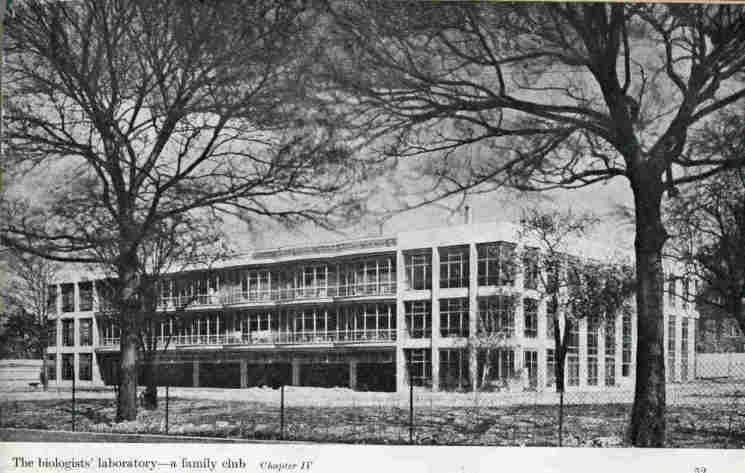
The Building
Set back 100 ft. from the pavement of a quiet street, only a stone’s throw from a main thoroughfare in South London, stands the building officially called the Pioneer Health Centre, but by those who use it, more familiarly known as “the Centre”. It consists of three large concrete platforms (160 ft. by 120 ft.), rising one above the other cantilevered widely over supporting pillars arranged in parallel series, surrounding a rectangular central space occupied by a swimming bath (35 ft. by 75 ft.). This form of construction on pillars allows the outer walls and those of the centrally placed swimming bath to be of glass, as indeed are nearly all the very few partition walls within the building. The front with its series of bow windows, the sections of which fold back in summer, presents to the eye a structure of open balconies one above the other, designed to be colourful with climbing creepers and to catch the afternoon sunlight.
Along one side of the top floor is the only space that is shut off from general circulation. It is a Consultation Block, consisting of private consulting rooms, reception rooms, changing rooms and biochemical laboratory. Except for its very frugal and light construction, this block has the more or less conventional appearance of a medical department of any modern clinic. The remaining part of the top floor consists of large light open spaces for quiet occupation, library and work-room, games, etc. The whole of the floor below, i.e. the first floor of the building, is taken up by a cafeteria and by a large hall for social purposes, from both of which the central swimming bath is visible through a continuous encircling band of glass window. From the long hall, looking down through two large windows on to the ground floor, are seen at one end a gymnasium and at the other a theatre. The rest of the ground floor consists of infants’ nurseries opening on to the grounds; of an infants’ and learners’ swimming bath, which again can be seen through a window from the passage leading to the nurseries; of cloakrooms, changing rooms and spray chambers, etc., for the bath, gymnasium and theatre. The land in front of the building, apart from an area of concrete used for roller skating, cycling, etc., remains largely in the rough awaiting development of the experiment to give direction to its lay-out.
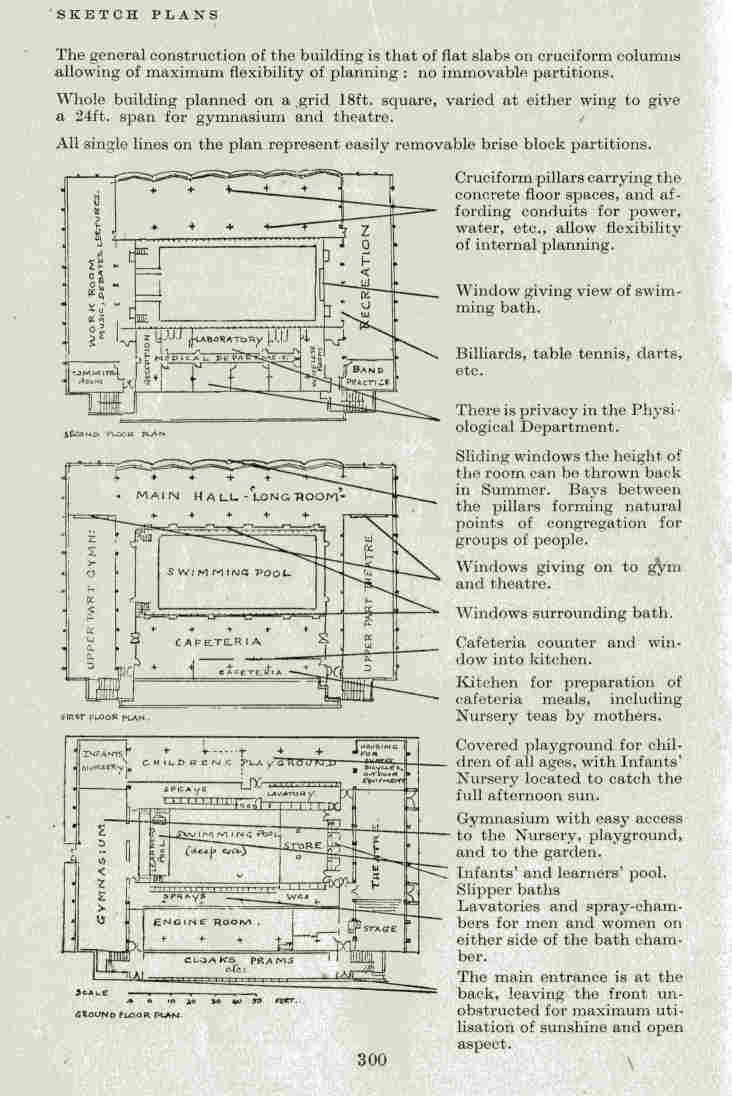
Here then is a modern building designed as a laboratory for the study of human biology. The general visibility and continuity of flow throughout the building is a necessity for the scientist. In the biological laboratories of botany and zoology the microscope has been the main and requisite equipment. The human biologist also requires special ‘sight’ for his field of observation—the family. His new ‘lens’ is the transparency of all boundaries within his field of experiment. Sixteen steps down from the consulting room and he is engulfed in the action that is going forward, and which, by reason of the very design of the building, is visible and tangible to his observational faculties at all times.
Apart from the architectural layout already described, what equipment was there in the building when it opened? A few books in the library, a billiard-table, games for the children, a gramophone, one or two pianos—nothing more. All the activities which later we shall see taking place in the Centre have been added one by one as the desire for them has arisen out of the association of the families gathering there. [For a list of the activities that have grown up in the Centre, see Appendix II.] It may be difficult in the first instance for the reader to conceive of such a building; difficult to rid the mind of a picture of a glass-house with large open spaces in which little comfort and sociability would be likely to forthcoming. To those who use it, it does not appear like this. The main social floor looking on to a blue-green swimming bath, the ripples of water casting their ceaseless reflexions on walls and ceiling, has at once an attraction that is unique. On the sunny side the building has gently curved window-bays and everywhere the large open floor spaces are broken up by pillars which, besides giving variation of light and shade, give a number of foci in the aisles about which intimate groups can form naturally without interfering with the continuity of circulation throughout the building. So that, although there are no culs-de-sac and no parts of the building shut away, there is no sense of living-in-a-passage nor of uninviting bareness.
To appreciate the salient features of its planning and purpose, it must be seen in use, for it is essentially a building designed to be furnished with people and with their actions. There for young mothers with time to spare in the afternoons, for infants ready for adventure, for school children to come to when school is over, for the adolescent as well as for both mother and father and all grown-ups when work is done, it is, too, a place where the family can foregather. The whole building is in fact characterised by a design which invites social contact, allowing equally for the chance meeting, for formal and festive occasions as well as for quiet familiar grouping. It is a field for acquaintanceship and for the development of friendships, and for the entertainment by the family of visiting friends and relations. In these times of disintegrated social and family life in our villages, towns, and still worse in cities, there is no longer any place like this. Nevertheless, man has a long history of such spaces that have met the needs of his social life and the tentative adventure of his children as they grew up:—the church, the forum, the market-place, the village green, the courtyard ; comfortable protected spaces where every form of fruitful social activity could lodge itself.
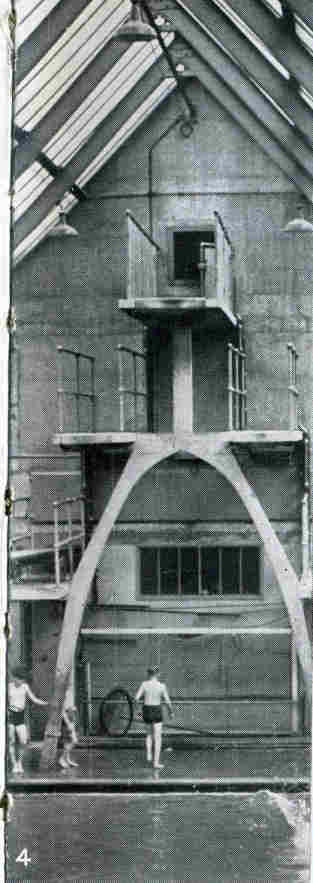
The Centre is just such a place, not modelled on the past, not traditional, but planned to meet certain biological necessities only now beginning to be understood. It is an open forum, with its recesses roofed and warmed in winter, yet open to the sunshine when it comes; a place where at all times any member of a family can drop in alone for an hour, or foregather for a party with equal ease and suitability—not a lounge for casual contacts, but an arena for the unfolding of the consecutive and integrated leisure activity of families.The plan is based upon the principles of biological cultivation. Action in the building is not to result from any professional leadership, but to arise spontaneously out of the circumstances of the environment freely impinging upon the families as they use it. So all activities, sequestered though they may be because of their intrinsic nature—e.g. the swimming bath, the gymnasium —are at the same time visible to all who use the building for any purpose. The swimming bath illustrates admirably this dual necessity in construction. It is in an enclosed chamber, the temperature and humidity of which can be controlled, but through its encircling band of glass it is visible to the occupants of the rest of the building, and it is sight of action going forward in the water that will constitute the familiarising factor stirring the spectator to new achievement and drawing non-swimmers to the attempt. So with the nurseries, the dance floor, cafeteria, theatre, library, workrooms, etc., etc.; all are planned to come within the vision of families and observers alike as they use the building.
The District
What families are they who use this building? After careful preliminary investigation for a suitable district the building was erected in Peckham, in the Borough of Camberwell in South East London, and in May, 1935, was opened to the use of any family living within an area of not more than a mile in extent from the Centre; that is to say within walking distance.
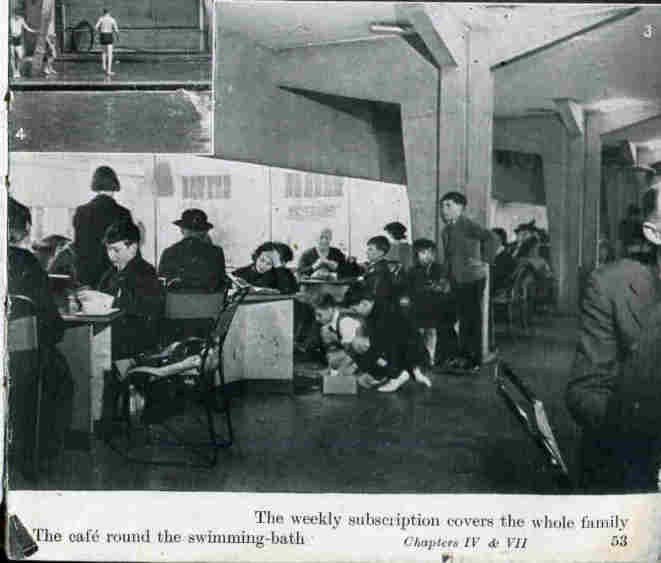
This locality was selected because of the varied types of family settled there: mainly artisans, occupied in every sort of skilled work, but also independent tradesmen, employers of labour, various grades of civil servants and municipal officers, clerical workers, some professional men as well as a few unskilled labourers. The income level of these families varies between £2 5s. 0d. per week and £1,000 a year or more, the large majority, however, earning between £3 10s. 0d. and £5 0s. 0d. per week. Thus varied in occupation and in income level, this populace roughly represents a cross-section of the total populace of the nation with as widely differing a cultural admixture as it is possible to find in any circumscribed metropolitan area. It is no sheltered group of workers but a sturdy people who have succeeded in keeping themselves in as fit a state as is possible in the face of present social conditions. [For a further analysis of the populace chosen, see “Biologists in Search of Material,” p. S5. See also Appendix III on nature of employment of Centre members.]
The houses in the district, each with a garden behind, are mainly of two or three stories, built originally to house one family, but most of them now occupied by as many separate families as there are floors to the house. Little alteration has been made in these houses to adapt them to their latter day use, so that the accommodation is far from modern, and the sanitary arrangements inappropriate for the families they now serve. Living within our small chosen area there are approximately 5,000 families.
The building as we have seen had to be designed to accommodate the leisure activities of 2,000 families. Taking the average metropolitan family to consist of 3.75 individuals, 2.000 families represent an aggregate of 7,500 individuals. Time has not yet allowed us to reach that membership, but we already know from experience that fewer than 1,000 families in continuous membership do not provide the diversity of types and of actions adequate for the spontaneous emergence of a sufficiently varied culture. After four years’ experience it still seems certain that twice that number is necessary, as originally postulated. But we have learned that the Centre as planned and built in Peckham is adequate in dimension and admirably suited in design for the use of the 2,000 families for which it was built. From the beginning we foresaw that any body of families linked in action as are the Centre members, would inevitably extend their associations beyond the confines of their club building. Thus the organisation would be bound, as a result of the growing activity of its members, to acquire extensions designed to meet the peak points of their leisure: half-holiday activities, week-end facilities, holiday camp, etc. This we shall see later has already begun to occur. Such extensions automatically relieve the pressure on the building when congestion is at its greatest. For all these, however, the Centre itself being the focus of initiation remains the integrating core.
Amidst the humdrum life of this residential district a new building has sprung up. The relatively few people who pass that way wonder what it is …. “They say it has a full-sized swimming bath, a gymnasium, a theatre, a cafeteria—where you can get beer”; dancing goes on there and moving figures can be seen on the floor of the main hall at night when the whole building is lit up attracting the attention of the passers by—if they have not already been led to pause by the strains of the band or singing filtering through the night air. What is the reaction of these passers by? Too often it is the normal reaction to novelty; they pass by without enquiry. There are relatively few questing and adventurous individuals in modern society, and this is a general characteristic, not one peculiar to any local populace. So the growth of membership of the first “Centre’ is likely to be slow. Circulars announcing its opening and advantages will for some long time be little more than convenient firelighters. Perhaps a passing couple will see the notice board —”Queer sort of place that; you have to have a medical overhaul ; wonder what goes on there?”—for they know few people in the neighbourhood and have never seen or heard of the place before. Or—”Let’s enquire at the gate”—and at once an invitation follows to come in and look round and to ask for the Secretary on reaching the first floor. Once inside, the atmosphere strikes them as friendly ; the process of familiarisation has begun. “Is it a Club? How do we become members?….”
A Family Club.
The Centre is a Club for families, [Our definition of ‘family’ is the mated pair, with or as yet without children. A widow or a widower are also (biologically) accounted a ‘family’.] admission to which can be gained by a family subscription of 1s. a week. The conditions and privileges of membership are two:—
- Periodic health overhaul for every individual of a member-family.
- Use of the Club and all its equipment, free to all children of school-age or under of a member-family, and by the adults on payment of a small additional sum for each activity.
These features are of a novel character. On first contact periodic health overhaul is likely to be confused by the man with medical overhaul, of which he may have had experience in industry where he is by no means convinced that it operates always to his benefit. In the second place, here is an invitation to engage in gregarious action which cuts across the ordinary conventions of social life where most actions are carried on in segregation. How often this finds expression in the term— “we keep ourselves to ourselves”—an assertion made by members of specialised groups,—e.g. of a tennis or a bridge club, as well as by adults in general. But with the children no such barrier exists. They prevail upon their parents to accept the invitation that the post has brought them to visit the Centre. They have heard of it from their school friends, often watched what is going on from the road, and sometimes even managed to get in with a friend who is a member. When they come they miss nothing and never cease to pull and to persuade till their parents decide to join.
So by the end of a year and a half, we had drawn 10% of the 5,000 families in the district chosen. [Early in 1938 the number of families having joined and remained members being still inadequate for the conduct of the experiment, and being ourselves pressed for money we were obliged to enlarge the district to include all families living within a mile in any direction. This subsequent area includes some 15,000 families. The results of this procedure cannot be given, since the war cut short the work before they could be adjudged. It was however apparent within a year that many factors other than walking distance operate to make membership possible or impossible; for instance, the presence of busy traffic routes across the path to the Centre may make it dangerous for children to come unaccompanied; the location of the shopping area in the opposite direction may make it difficult for a mother to visit both it and the Centre in the one day. The position of the school or of the station used by the workers, the tram or bus route—trivial though they seem—all operate to determine the frequency with which the building can be used by a family, and hence the duration of their membership. In “Biologists in Search of Material” the personal and individual factors operating for and against membership have been fully discussed. There are however two general factors of which we had become acutely aware towards the end of the fourth year. Even as late as this, families were continuing to join who, although they had lived in the district, had never heard of the Centre till the week before; of people whose daily tracking was so consistently conditioned by circumstance and so closely confined by habit that, although they daily used the station 100 yards from the building, had never seen it and were unaware of its existence. The second fact of importance to membership is the constant shift of the urban population; here for a year, then gone to the next temporary halt, never long enough anywhere to grow any roots in society. From a survey made by us in 1938, it appears that of those whose membership of the Centre lapsed, 43% had left because they had moved from the district.
Certain other essential points in the constitution of the Centre and the technique used must be discussed. The subject of maintenance is one of the first questions asked by any visitor.
The organisation has been designed, with the achievement of full membership, to become a self-supporting one. The main sources of calculable revenue are two: first the weekly family subscription at Is. a week per family, with full membership of 2,000 families yielding £5,000 a year; second, a further estimated sum of Is. a week net per family, derivable from the sum of small amounts paid by all adult members for whatever they do in the building—e.g. 3d. for a swim, 6d. for a whist drive, etc. —which should yield a similar sum; these two main sources of revenue together giving an estimated revenue of £10,000 a year.
The unfamiliar nature of the enterprise to the populace, the experimental nature of the venture in which the requirements of research must take first place, and the relatively short time we have been established, all make it impossible yet to demonstrate the validity of this financial estimate. So far we can only say that the sum chosen for the weekly subscription is well within the capacity and acceptance of the wage-earners we cater for—for many, considering the sum fixed to be an inadequate one for the advantages accruing to them, asked to be allowed to pay more. The amount of extra money forthcoming as an average sum per week from each family we have found by experience to be within reasonable reach of the sum estimated. It depends on the rate of growth of the Club, for the more members there are, the greater number of activities are likely to be in progress; and the more the Centre is used, the larger is the proportion of spare money spent there.
What of the outgoings? For such an organisation to be self-maintaining a great deal of thought and ingenuity must be put into its initial planning with a view to reduction of the cost of maintenance. Some of the scientific requirements of the experiment have also a bearing on the financial aspects of running the Club. Of these, two illustrations might be given, the nature of the service, and the method of collecting and recording entrance subscriptions and other takings.
Self-Service Technique.
The ‘self-service’ aimed at throughout the buildings is a primary need of the biologist. A healthy individual does not like to be waited on; he prefers the freedom of independent action which accompanies circumstances so arranged that he can do for himself what he wants to do as and when he wants to do it. The popularity in tube stations of the moving-staircase compared with the lift attests to this. It is not merely speed, but the possibility the moving-staircase gives for independent individual action as opposed to collective action dependent upon an attendant, that is significant. Servants tend to bind and circumscribe action, for their presence makes inevitable the establishment of a routine that only too often rebounds upon their employers.
Self-service has the merit of engendering responsibility and of enhancing awareness as well as of increasing freedom of action. As unhampered in the Centre as in their own houses, the members are free to improvise to suit all occasions as they arise. As the embryo newly lodged in the womb begins to build its cells into the substance of the uterine wall, so each new family emboldened to strike out for itself in this living social medium can add its own quota of ‘organisation’ to the Centre—the outstanding characteristic of which is the abiding fluidity of its constitution, permitting continuous growth and the functional evolution of its society from day to day and from year to year.
So in the Centre there are no attendants, no waitresses. This means that where possible all equipment has had to be designed to be handled by the members themselves. In the main the furnishings are light stackable tables and chairs which can be moved from place to place as occasion demands; the cafeteria utensils also are stackable and devised to be taken and replaced by the members. These are seeming trifles, but they have their far-reaching significance in the type of social organisation that is growing up in the building.
In designing the building it was far from a simple matter to assemble this type of equipment. It is often not recognised that though quick-service installations exist here and there in restaurants, there has been no self-service in this country. Much research and ingenuity therefore remain to be devoted to this subject to bring it to anything like practicability. The initial stages moreover are costly. To give a simple example: £60 had to be paid for the first mould for a simple article such as an unbreakable plastic plate-saucer; in use it was found to chip readily and had to be replaced by a metal one, for the initial pattern of which a further similar sum had to be paid. A suitable design once on the market, no subsequent Centre would have to incur these initial charges. This instance is only one of the innumerable small difficulties encountered in equipping the Pioneer Health Centre. Designs for durable and accurately stacking bowls and glasses had to be worked out and produced.
Again, there is no apparatus made for the orderly reception of dirty utensils in soaking-fluid from which they can be removed and washed the following morning—thus avoiding unnecessary night work. Modern materials should make all these possible and cheap, but they still remain to be designed, made and reproduced.
The provision of facilities for self-service in all Centre activities, means that the cost of maintenance and of staff salaries remains more or less constant. The cost of running the Centre, therefore, need not rise with increasing membership, though obviously as new activities of the members arise, certain further capital outlay is necessary.
The Key
Another instance of the necessity for designing not only a new type of building but also new installations to meet its purposes can be given. Research requirements necessitate a record of entrances and exits and the times of day when these occur, as well as a record of the activities of each individual once in the building. It is also very desirable to devise some impersonal method of collecting subscriptions, and to minimise the cost of collection. These requirements have led to the formidable task of the invention of a multiple purpose ‘key’ for the use of each individual of a member-family. This key is a small circular disk [The key was designed by Dr. G. Scott Williamson and constructed under his direction. It was paid for out of a bequest for research from the late Sir Henry Van den Bergh and was about to be installed when war broke out.] ? inches in diameter and ? inch thick, with a ring to hang on the watch chain or key ring. It gives access to the building to each individual of every member-family and forms an entrance tally recording on a moving sheet the family number, which individual of the family, and the time he enters; it passes him in for a week after the family subscription has been paid, but excludes him and his family until this duty has been fulfilled on the 8th day; it also permits of his attention being called on entering the building if for any reason he is wanted. Besides this, by means of subsidiary recording machines, it affords entrance to any special activities on payment of the required sum, again giving a record of entrance and time for statistical purposes. Suppose the scientist should wish to know what individuals are using the swimming bath or consuming milk, the records made by the use of the key give him this information. It was three years before time could be found to design and construct this instrument. In the meantime subscriptions and payments have had to be taken and recordings made by individuals whose time has been largely devoted to this purpose only. But the organisation was from the beginning planned with an installation of this nature in view; it is as necessary for the purposes of research and for disembarrassing the observer of duties connected with control, as it is desirable for freeing the individual member and useful in diminishing the running costs of the Club.
Attitude of the Staff
How does all this affect the work of the biologist? As observer moving about the building, he now comes to be in much the same position as any member—able to exercise his preference in action. As we have seen, these preferences are for the accumulation of knowledge and information about the families gathered there. The branches of knowledge in which he is particularly interested are, as we have also seen, those which concern the biological capacities of the families, and those which concern the actional or social capacities of the individuals of those families.
Upstairs in the physiological department, medically trained biologists have a group of instruments which the families use. thereby giving a record of their physiological balance. Here then is our biologist, appearing primarily to be occupied with the task of periodic health overhaul set in the family environment in a guise sufficiently like that of a family doctor to make him familiar and acceptable to the family. But, it may be asked, is he acting in a medical capacity?—and that is a most important question. He needs close watching. Perhaps before an answer can be given, the aims and practice of Medicine will need redefinition in the terms of modern Science. All we know so far is that the biologist is among families to find out facts, to disentangle reality from illusion, from phantasy, even from aspiration —whether his or theirs. He is there to look at each family ; not as it could be, but as it is and as it will act in the new conditions created.
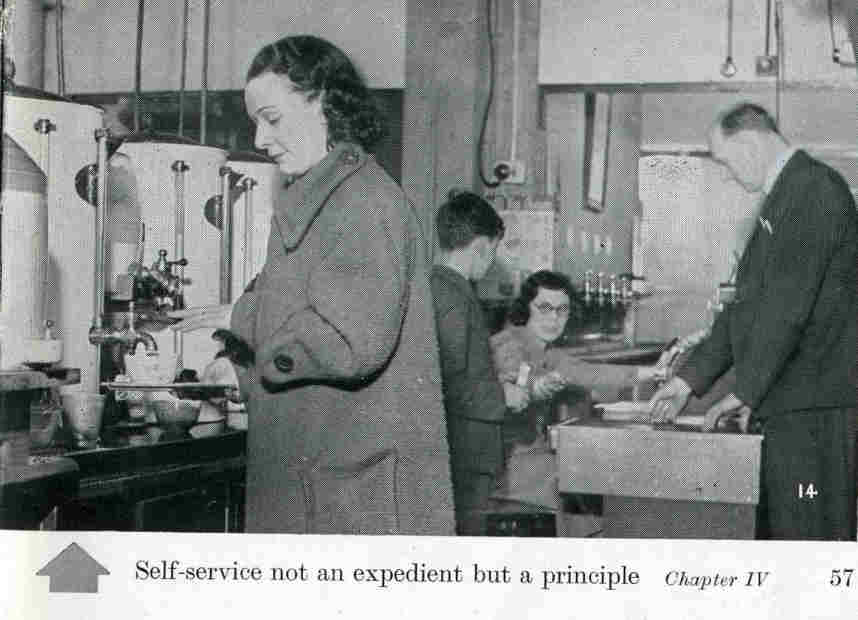
But there is another aspect of this biologist’s work. On the social floor of the building there are also ‘instruments’; for all the equipment throughout the building—the billiard tables, the skates, even the floor space—from the biological point of view, are instruments for the development of the potentialities of the member-families, while at the same time being the means’ for assessing the growing capacities of individuals and families alike. Of these instruments for action and recording, the social biologist moving constantly throughout the building is Curator, keeping the use of everything available for those desiring to use it, and at the same time recording the manner and results of its use.
The training of the staff is difficult. It is in fact no easy thing for the individual as a scientist to place himself as an instrument of knowledge completely at the disposal of any and every member, and at the same time, without exercising authority, to assume his right and proper position in the community as a social entity. But he is also there to make observations. This the members have readily come to accept, jokingly describing themselves as the biologist’s “rats”. They soon come to appreciate that the scientist’s primary concern is to be used by the members as a, means of reaching and sustaining their own maximum capacity for health. Moreover, they come to sense that in carrying on their own activities and inaugurating new ones through the method of selfservice, many of them are in fact step by step themselves growing into important members of the staff.
So at the end of four years there is little to distinguish members from staff in the social interplay of the Centre. The whole medium is social—Science socialised. The Centre has, in fact, shown itself to be a potent mechanism for the ‘democratisation’ of knowledge and of action.
